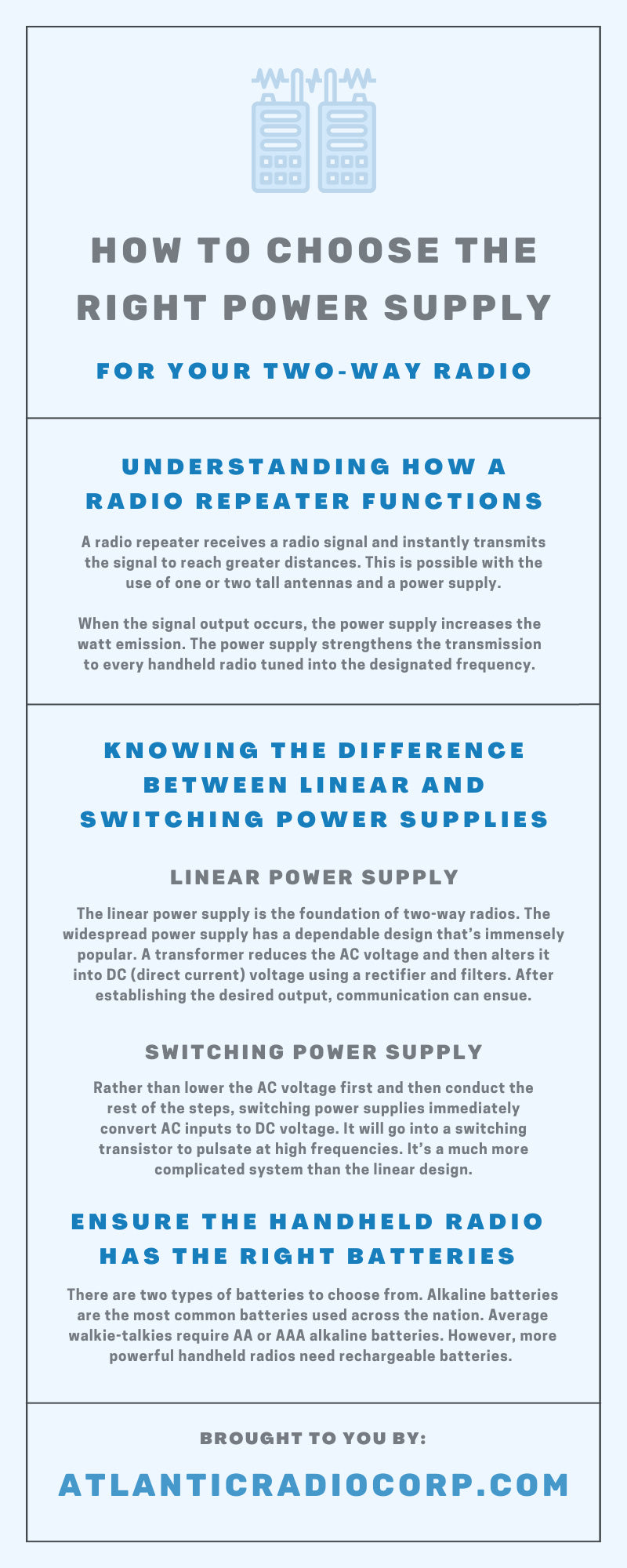
How To Choose the Right Power Supply for Your Two-Way Radio
, by John Gabriel, 6 min reading time

, by John Gabriel, 6 min reading time

Believe it or not, two-way radios are powerful devices. They can provide access to communication when the internet and cell phone towers are non-existent. You may be running a construction site or assisting during a natural disaster. No matter the case, you need access to communication.
Two-way radios are reliable devices that send clear transmissions across various distances. The secret to ensuring your two-way radio doesn’t fail is to choose the right power supply. Continue reading to learn how you can make this decision for your two-way radio.
Radio signals travel in straight lines in a “line of sight” path. On average, the maximum distance that two-way radios will reach is to the horizon due to the earth’s natural curvature.
Without the presence of a radio repeater, handheld radios have only “line of sight” communication. If any obstacles are in the way, transmissions are even less efficient.
A radio repeater receives a radio signal and instantly transmits the signal to reach greater distances. This is possible with the use of one or two tall antennas and a power supply.
The antenna should be in a central location to maximize the radio signal in all directions. The higher in the air the antenna reaches, the further the connection can reach. Not to mention, it decreases the likelihood of buildings and hills obstructing frequencies.
Now, there’s the need for a power supply, but how does it work? When the signal output occurs, the power supply increases the watt emission. The power supply strengthens the transmission to every handheld radio tuned into the designated frequency.
The power supply affects how far the frequencies will reach. Without the right power supply, you can’t efficiently communicate. There are two options to choose from—linear or switching power supplies.
The linear power supply is the foundation of two-way radios. The widespread power supply has a dependable design that’s immensely popular.
A transformer reduces the AC voltage and then alters it into DC (direct current) voltage using a rectifier and filters. After establishing the desired output, communication can ensue.
This type of power supply can be more expensive due to its high-power qualities. Keep in mind that this power system is also more likely to generate excessive heat. This can result in less energy efficiency, potential damage to the power supply, and cut-out transmissions.
One of the most favorable benefits of linear power supplies is the ability to reduce electromagnetic noise. It’s a common issue for many two-way radio stations that hinder clear communication.
The other option is the switching power supply. It’s a newer, more advanced model that surpasses linear power supplies in many features.
Rather than lower the AC voltage first and then conduct the rest of the steps, switching power supplies immediately convert AC inputs to DC voltage. It will go into a switching transistor to pulsate at high frequencies.
The DC voltage becomes AC once again during this process, reducing the AC to a low voltage of 12 to 15 volts. Then, the AC voltage will finish the process of rectification and filtration and emit power through the two-way radio.
It’s a much more complicated system than the linear design. The improved design results in a power supply that generates less heat no matter the environment and operates at high-efficiency rates.
A troublesome disadvantage of this model is the chance of radio frequency interference. The constant buzz may make it difficult to always hear transmissions clearly. Therefore, additional noise filters are a must to suppress the AC power supply cable.
Choosing the right power supply for two-way radios requires you to know about the two different types and which will work for your needs. You need increased communication range and quality. Every brand is different, so take your time before buying just any power supply on a whim.
Some two-way radio models allow you to select the power output of the device. This is great for users who don’t have a definite communication range. Some days might demand ample power for communication across long distances, while others require transmission for a small area.
If you need more alternatives for your two-way radio, power selectable features are a great feature to have!
Select the low-power option on days when you’re conducting short-range communication. The power reduction prolongs the battery life and minimizes the risk of outside parties listening in. You’ll maintain healthy batteries and ensure communication solely among the desired individuals.
The chosen power supply is the commencement for two-way radios to function. Each handheld radio will need to be on the correct frequency to communicate. However, none of the radios can work if they don’t have batteries.
There are two types of batteries to choose from. Alkaline batteries are the most common batteries used across the nation. Average walkie-talkies require AA or AAA alkaline batteries.
However, more powerful handheld radios need rechargeable batteries. Whenever the power is low, plug the batteries into the proper charger for full capacity.
Rechargeable batteries supply more power, are more eco-friendly, and are more affordable for consistent use. A few options include lithium ion, nickel metal hydride, and nickel-cadmium batteries. The type of battery you need will depend on the particular handheld radio model you have.
There are plenty of two-way radio products out in the world. Try to avoid buying the first good deal you find online. You want a high-quality product that you know will reach the desired communication range and result in clear transmissions.
While you might think you’re getting a great deal on a high-end switching power supply, you might receive a piece of equipment that consistently emits muffled transmissions. Never experience muffled transmissions from a low-grade piece of radio equipment again by choosing the right products.
Choosing a reliable manufacturer from a company you can trust is a good start. Atlantic Radio Communications is here to assist!
We supply a variety of name-brand products that will meet your preferences, from Hytera mobile radios to antennas to radio repeaters. Everything you need is here at Atlantic Radio Communications.
